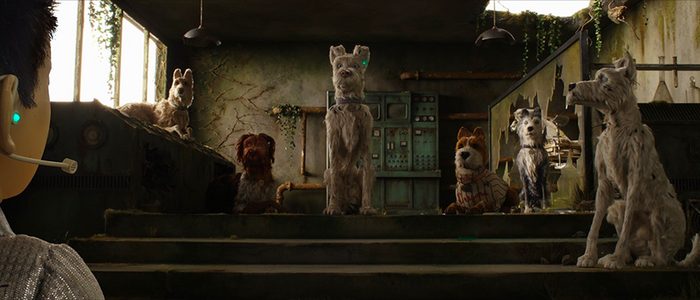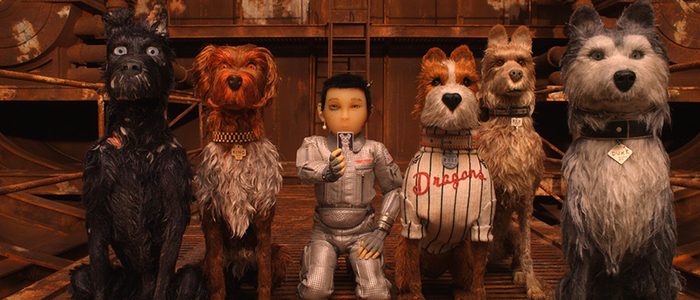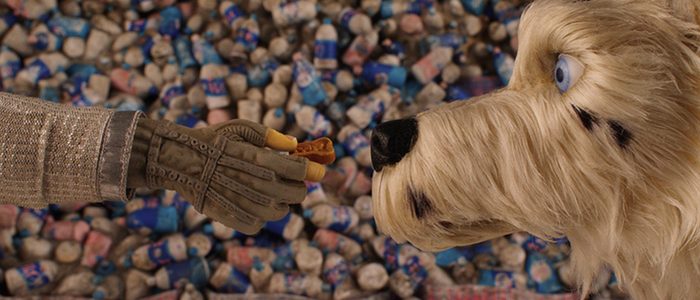'Isle Of Dogs' Spoiler Review: Good Dogs, Problematic Material
(In our Spoiler Reviews, we take a deep dive into a new release and get to the heart of what makes it tick...and every story point is up for discussion. In this entry: Wes Anderson's Isle of Dogs.)With Isle of Dogs, Wes Anderson returns to the magical world of stop-motion for the first time since Fantastic Mr. Fox. The results are frustrating. On one hand, Anderson has crafted a genuinely emotional, frequently funny adventure focused on man's best friend. On another hand, Anderson has, for some inexplicable reason, decided to use the film to turn Japanese culture into a punchline.
No Future On Trash Island
In the not-too-distant-future, a sudden outbreak of dog flu has put a large population of Japan's dogs on the chopping block. Megasaki's Mayor Kobayashi (Kunichi Nomura) has a solution – banish all dogs to Trash Island. Anti-dog sentiment runs rampant, and soon all the puppers are hauled off to live among the mountains of waste, with the presumption that they'll die out. But the dogs survive, and form their own packs.One such pack consists of former house pets – Rex (Edward Norton), former dog food commercial star King (Bob Balaban), former baseball mascot Boss (Bill Murray) and the gossip-loving Duke (Jeff Goldblum). Also in the pack (sort of): Chief (Bryan Cranston), a gruff stray who is prone to biting humans who dare to attempt to pet him.This pack, and hundreds of other dogs, have been scraping out a rough existence on Trash Island for six months when a human drops in out of the blue – literally. A small plane crashes on the island, flown by young boy Atari (Koyu Rankin). Atari is the adopted nephew of Mayor Kobayashi, and has come in search of his dog and bodyguard Spots (Liev Schreiber).The pack agrees to help Atari search Trash Island for Spots, with Chief begrudgingly coming along. Throughout the journey, Chief's icy heart begins to thaw a bit as he grows closer to Atari.Meanwhile, Mayor Kobayashi and his corrupt administration are hatching a plan to exterminate the dogs. Kobayashi comes from a long-line of cat lovers, and it was actually Kobayashi and his goons who infected all the dogs with dog flu. A group of student activists, lead by exchange student Tracy Walker (Greta Gerwig) have caught on to Kobayashi's plan, and are racing against the clock to save the pups.Lessons are learned, tears are shed, and we get to spend a good amount of time with some very good dogs.
They’re Good Dogs: What Works
Like Fantastic Mr. Fox, Isle of Dogs is a visual wonder. In fact, it's an even bigger technical achievement than Mr. Fox, which was set in a rural, and frequently empty, setting. Here, Anderson's team of stop-motion animators have crafted a several huge, expansive settings – from the futuristic cityscape of Megasaki to the ever-shifting landscape of Trash Island. Every moment of the film features stunning visuals – rolling seas that sparkle like diamonds; billowing tall grass on an abandoned golf course; a dog drop-off point overflowing with empty cages. There's one scene set within an igloo constructed of lit, multi-colored sake bottles that's breathtaking to behold. And then there are the dogs themselves, each with their own unique visual traits. Like Mr. Fox, and like the Rankin/Bass stop-motion movies of yesterday, the fur on the dogs is almost always moving; bristling, be it in a breeze or from the touch of an animator. It's almost hypnotic – you can get lost in all that ruffling fur.The animation is more fluid here than in Mr. Fox, which often featured movements that felt jerky and haphazard. Yet the animation alone isn't what brings these dogs to life. The voice work, handled by mostly Anderson mainstays and a few new additions, is stellar across the board. Bryan Cranston in particular gives one of the very best performances of his career (I'm serious!) as the rough, standoffish Chief. Chief does not care for humans, yet slowly comes around to appreciating Atari. Cranston sells this slow change in the character perfectly – it never seems abrupt or forced. There's a heartfelt amount of emotion in the way Cranston delivers certain lines, such as a tear-inducing story about the one disastrous time he was adopted by a family of humans. They don't give out big time award nominations for voice work, but if they did, Cranston would be a shoo-in for the performance he gives here. I sincerely hope Anderson works with him again – in live-action.The rest of the dog pack handles themselves nicely as well. Edward Norton is bossy and smarmy, in just the right way, as the default leader Rex. Bill Murray's Chief doesn't have as much to do, but the actor still conveys the same droll Bill Murray charm that he's patented for decades. Bob Balaban is just the right mix of nervous and pensive as King. And Jeff Goldblum is at his Jeff Goldblumiest as Duke, a dog who loves gossip and frequent begins conversations with, "Did you hear about...?"While Isle of Dogs is very much a Wes Anderson movie, it often signifies an evolution in how Anderson tells a story. There are more quiet moments here than in previous films; even the soundtrack, which features a killer score courtesy of Alexandre Desplat, goes light on the pop music that pepper Anderson's other films. Anderson gets a lot of guff – sometimes deservedly so – for what can be seen as his twee-ness, but when he wants to hit a very specific emotional beat, he usually nails it.Think of how blunt and simple, and yet how effective, Ben Stiller's line, "I've had a rough year, Dad," comes across at the end of The Royal Tenenbaums. Such a fact-of-the-matter utterance shouldn't connect as well as it does – and yet...it does. The same can be said for several moments in Isle of Dogs. When Atari first meets Spots, Anderson stages a scene where the boy and the dog begin communicating with each other via a special headset. Atari is whispering something we can't really hear, but the camera goes in tight on Spot's face, and the dog keeps saying, "I can hear you," over and over again, as tears well up in his eyes. It's almost overwhelmingly emotional in its simplicity.Another simple moment that somehow destroyed me, emotionally: Chief takes a fancy to another dog on the island – a former showdog named Nutmeg (Scarlett Johansson). She asks Chief if he'll help Atari on his quest to find Spots. "Why should I?" Chief asks. "Because he's a twelve year old boy," Nutmeg replies. "Dogs love those." Here, Anderson holds for a beat of silence, and in that silence there's some sort of unspoken, beautiful truth that punched me in the gut.The same goes for a scene near the end of the film, where Spots transfers his duties as Atari's bodyguard over to Chief, and Chief – who has spent nearly the entire film talking about how much he hates humans – accepts the job. These moments, coupled with bursts of humor – a recurring gag involves a pug (voiced by Tilda Swinton) the other dogs see as psychic, when in fact she gets all her psychic visions from watching TV, is consistently hilarious – make Isle of Dogs sincerely effective.And yet...
Bad Dog! What Doesn’t Work
There has been a much-talked about, and important, conversation surrounding Isle of Dogs, and what many perceive to be its cultural appropriation. /Film's own Hoai-Tran Bui wrote an excellent piece wading into this particular topic, saying: "It's not the fact that Anderson deigned to pay homage to Japanese culture, or that his fairy tale version of Japan intentionally mocks or belittles the culture. It's that his vision of Japan descends from a long history of cultural inventions that have historically insulted and mocked Asian characters."Anderson chose to set Isle of Dogs in Japan, primarily to pay tribute to the films of Akira Kurosawa. "This is definitely a reimagining of Japan through my experience of Japanese cinema," he said. I actually give Anderson the benefit of the doubt here, and I truly think he didn't intend for Isle of Dogs' depiction of Japanese culture to come across negatively. That said, there's a very real sense that Isle of Dogs is treating Japanese culture, and its Japanese characters, as a punchline. Whether or not this was intentional on Anderson's part is irrelevant. The audience I saw the film with cracked up several times at the way the film presented its Japanese characters – and this laughter irked me, because it felt as if these individuals were laughing at the characters, not with them.What makes this all so frustrating is how avoidable it was. For one thing, there's almost nothing in this story that anchors it to Japan and Japanese culture. In other words, Anderson could've set the film in New York City and it would virtually the same story – while bypassing the apparent cultural appropriation. That said, if Anderson felt the story must be set in Japan, he should've worked to ensure Japanese culture wasn't the butt of a joke.The worst misstep on Anderson's part is by figuratively not letting the Japanese characters speak for themselves. Rather than provide subtitles for the Japanese-speaking individuals in the film, Anderson employs a running joke about a translator, voiced by Frances McDormand, providing the audience with an English translation. Often, McDormand's narration will drown-out the Japanese being spoken – in a sense, Anderson is robbing these individuals of their own voice. This whole idea comes across like something that perhaps looked funny on paper, but backfires when employed in the film.These unfortunate moments aren't a constant thing, but they reoccur enough to hurt the film. Just when you're settling into Isle of Dogs' otherwise lovely wavelength, it doubles-down on its goofy treatment of Japanese culture, and leaves a bad taste in your mouth in the process.Pacing is the film's other key issue. At 101 minutes, Isle of Dogs feels overly long. The narrative sags considerably, primarily due to a lengthy flashback sequence that arrives late in the film. While said flashback is essential to the story, it has the unfortunate effect of derailing the momentum previously built up.
The Middle-Ground
Isle of Dogs left me frustrated. There's so much here to love and cherish. Indeed, there are emotional beats in this film that I suspect will linger with me for the foreseeable future. And yet, through it all, there's the near-fatal miscalculation on Anderson's part in the handling of the cultural elements of the film.Perhaps Isle of Dogs' greatest achievement is that it's a much-needed reminder that some films exist somewhere between fantastic and woeful. The modern approach to films – especially in the case of online criticism via YouTube critics – seems to fit a film into one of two categories. Either the film is amazing or garbage. There's no in-between. In this particular mindset, a movie can apparently either be the best movie ever made or the worst movie I've ever seen.But that simply isn't true. Films contain multitudes, and sometimes, a movie can have both excellent, laudable elements and also scenes that just don't work. Isle of Dogs exists in this area. It gets so much right, while also getting so much wrong. That doesn't mean it's not worth our attention.At the very least, you should be able to take comfort in this truth about Isle of Dogs: they really are good dogs.
